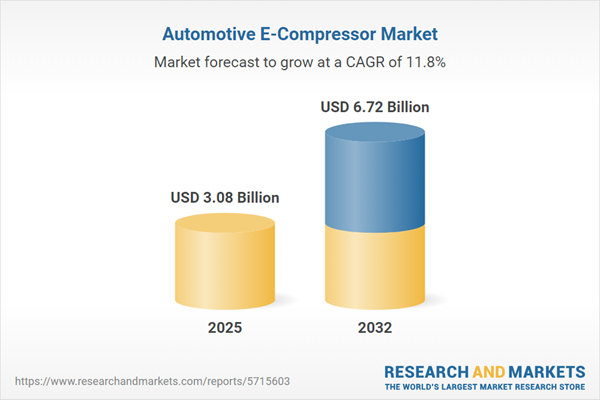Speak directly to the analyst to clarify any post sales queries you may have.
The automotive e-compressor market is undergoing notable transformation as electrification trends, regulatory shifts, and evolving procurement practices reshape the competitive landscape. Senior decision-makers require actionable insights to navigate these shifts, identify growth opportunities, and ensure robust operational resilience.
Market Snapshot: Automotive E-Compressor Market Growth
In 2024, the global automotive e-compressor market is valued at USD 2.76 billion and is expected to reach USD 3.08 billion by 2025. With a compound annual growth rate of 11.75% projected through 2032, the market could reach USD 6.72 billion. This strong momentum is shaped by advancing global emissions standards, OEMs’ increasing emphasis on performance, and the industry-wide need for regulatory compliance. Widespread adoption of electrified compressor systems is influencing business strategies for manufacturers, suppliers, and technology firms. Market opportunities are expanding as collaborative integration supports both legacy participants and new entrants across automotive value chains.
Scope & Segmentation: Automotive E-Compressor Market
This report equips senior leaders with a structured approach for evaluating investments, sharpening supplier selection, and mitigating supply chain risk throughout ongoing technology evolution. Comprehensive segmentation facilitates strategic planning and targeted adoption of relevant technologies across the automotive sector.
- Compressor Types: Axial, centrifugal, rotary screw, and scroll compressors address the needs of electric, hybrid, and conventional vehicles, supporting manufacturers in diversifying propulsion and energy management strategies.
- Vehicle Types: Both commercial vehicles and passenger cars are considered, guiding executives in engineering adaptations and product customization based on regulatory and operational influences.
- End Users: The landscape spans original equipment manufacturers (OEMs) and aftermarket participants, whose procurement decisions and partner collaborations shape market evolution.
- Applications: Supercharging and turbocharging support propulsion flexibility, especially across mild hybrid and battery-electric vehicles, aligning architectures with varied powertrain specifications.
- Power Ratings: Segment coverage includes outputs below 75 kW, 75–150 kW, and above 150 kW, meeting needs from fleet deployments to specialty applications across global vehicle portfolios.
- Regional Coverage: Analysis spans the Americas, Europe, Middle East & Africa, and Asia-Pacific, highlighting regional supply networks, manufacturing capabilities, and consumer trends guiding market strategies.
- Company Analysis: Comparative assessment of leading firms, including Denso Corporation, Valeo SA, MAHLE GmbH, Hanon Systems Corporation, Sanden Holdings Corporation, Continental AG, MARELLI Corporation, Valeo Siemens eAutomotive GmbH, Vitesco Technologies GmbH, and Nidec Corporation, focusing on technology direction, partnerships, and the evolving competitive environment.
Key Takeaways
- Industry leaders are adapting management and integration strategies to better address stringent compliance standards and dynamic operational requirements in the automotive e-compressor market.
- Collaboration among manufacturers, suppliers, and technology partners is facilitating quicker development cycles and enabling broader deployment across established and emerging vehicle platforms.
- Supply chain resilience benefits from regionally focused manufacturing and sourcing diversification, reducing vulnerabilities tied to policy and regulatory change.
- Commercial and fleet operators are placing greater value on reliability and lifecycle performance, while passenger vehicle OEMs prioritize flexible compressor design to accommodate changing propulsion demand.
- Asia-Pacific stands out for driving technology innovation and e-mobility adoption, bolstered by strong supplier relationships and advanced manufacturing investments, setting benchmarks for other regions.
- Production and procurement strategies are continuously refined to remain agile as compliance and technology landscapes change, supporting competitive positioning.
Tariff Impact: U.S. Policy Shifts and Strategic Implications
Recent adjustments to U.S. tariff policy are prompting global automotive firms to strengthen domestic supplier partnerships and expand sourcing channels. This approach minimizes vulnerability to trade disruptions and safeguards operational continuity under shifting policy conditions.
Methodology & Data Sources
Insights in this report derive from direct interviews with engineering and procurement leaders, complemented by detailed industry surveys and peer review. Scenario-based market modeling supports precise strategic planning for varying operational and regulatory contexts.
Why This Report Matters
- Senior decision-makers gain structured frameworks for identifying market changes, assessing opportunities, and informing transformation priorities.
- Comprehensive analysis helps organizations navigate evolving supply chain dynamics and mitigate emerging risks in global procurement.
- Collaboration models within the report support alignment of engineering, sourcing, and project objectives for targeted operational achievements.
Conclusion
Applying these insights enables organizations to manage compliance requirements, leverage technological advancements, and optimize procurement strategies, positioning them to strengthen competitiveness in the evolving automotive e-compressor market.
Additional Product Information:
- Purchase of this report includes 1 year online access with quarterly updates.
- This report can be updated on request. Please contact our Customer Experience team using the Ask a Question widget on our website.
Table of Contents
3. Executive Summary
4. Market Overview
7. Cumulative Impact of Artificial Intelligence 2025
List of Figures
Companies Mentioned
The companies profiled in this Automotive E-Compressor market report include:- Denso Corporation
- Valeo SA
- MAHLE GmbH
- Hanon Systems Corporation
- Sanden Holdings Corporation
- Continental AG
- MARELLI Corporation
- Valeo Siemens eAutomotive GmbH
- Vitesco Technologies GmbH
- Nidec Corporation
Table Information
| Report Attribute | Details |
|---|---|
| No. of Pages | 185 |
| Published | November 2025 |
| Forecast Period | 2025 - 2032 |
| Estimated Market Value ( USD | $ 3.08 Billion |
| Forecasted Market Value ( USD | $ 6.72 Billion |
| Compound Annual Growth Rate | 11.7% |
| Regions Covered | Global |
| No. of Companies Mentioned | 11 |









